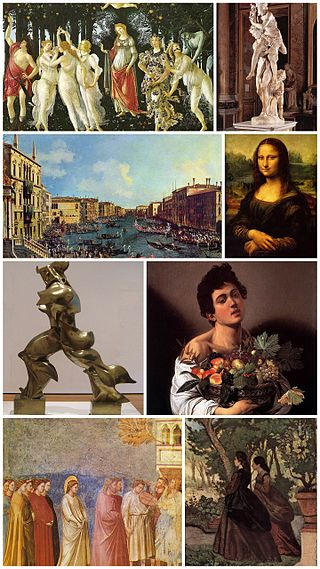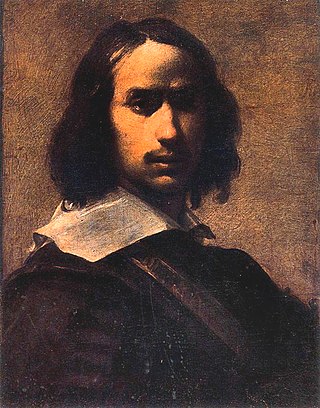Related Research Articles

Francis Petrarch, born Francesco di Petracco, was a scholar and poet of the early Italian Renaissance and one of the earliest humanists.
This article contains information about the literary events and publications of 1555.

The cultural and artistic events of Italy during the period 1400 to 1499 are collectively referred to as the Quattrocento from the Italian word for the number 400, in turn from millequattrocento, which is Italian for the year 1400. The Quattrocento encompasses the artistic styles of the late Middle Ages, the early Renaissance, and the start of the High Renaissance, generally asserted to begin between 1495 and 1500.

Francesco Cozza was an Italian painter of the Baroque period.

Francesco Cairo, also known as Francesco del Cairo, was an Italian Baroque painter active in Lombardy and Piedmont.

Girolamo dai Libri was an Italian illuminator of manuscripts and painter of altarpieces, working in an early Renaissance style.

Domenico Morone was an Italian painter from Verona, painting in an early Renaissance style. Much of his work has not survived, notably his fresco cycles. He was considered by Vasari to be second only to Liberale da Verona among artists in his town. His son Francesco Morone was also a prominent Veronese painter. His pupils included Michele da Verona and Girolamo dai Libri.

Epistolae familiares is the title of a collection of letters of Petrarch which he edited during his lifetime. He originally called the collection Epistolarum mearum ad diversos liber but this was later shortened to the current title.

Francesco Vecellio was a Venetian painter of the Italian Renaissance. He was the elder brother and close collaborator of the painter Tiziano Vecellio ("Titian").
Events from the year 1555 in art.
The decade of the 1470s in art involved some significant events.
The decade of the 1450s in art involved many significant events, especially in sculpture.
Francesco Bassi was an Italian painter active in the early-Baroque period, mainly in his hometown of Cremona, but also in Venice. He was also known as Francesco Maria Bassi the elder.
Francesco Traballesi was an Italian painter and architect. He was born in Florence in 1541, flourished in Rome during the papacy of Pope Gregory XIII (1572–1585), and died in 1588 in Mantua, where he was working as an architect for the duke Vincenzo Gonzaga. In the Roman church of Sant'Atanasio dei Greci, which was founded by Gregory, there are two altar-pieces by Traballesi, an Annunciation, and a Christ disputing with the Doctors, while in the Greek Pontifical College of Saint Athanasius, next to the church, are more of his paintings, with Apostles, Fathers of the Church, and a Crucifixion, which were once parts of the iconostasis of the church itself. In the Town Hall of Tivoli, anciently called Tibur in Latium, are two frescoes painted by Traballesi in 1574, showing scenes of The mythic foundation of Tibur. After his wife died, he was ordained into the Dominican order. He had three brothers who also worked in the arts: Bartolommeo Traballesi was an assistant painter for Vasari; Felice was a sculptor, and Niccolo, a silversmith. Five of his sisters were nuns in the order of St Catherine.

Francesco Zucchi, was an Italian engraver, active mainly in Northern Italy.
Diego de Arroyo (1498–1551), a Spanish miniature painter born at Toledo, is supposed to have studied either in Italy or under an Italian master. His delicate miniature portraits gained him much renown, and the appointment of painter to Charles V. He also illuminated choir-books for the cathedral of Toledo. Arroyo died at Madrid in 1551.

Attavante degli Attavanti was an Italian painter.
Fra Benedetto da Fiesole, also known as Benedetto da Mugello was an Italian artist.
Libri may refer to:
Anselmo Canera, or Canneri, was an Italian painter of the late Renaissance, born and mainly active in Verona. He is noted for his frescoes and his collaborations with other Italian artists such as Bernardino India and Paolo Veronese.
References
 This article incorporates text from a publication now in the public domain : Bryan, Michael (1886). "Dai Libri, Francesco". In Graves, Robert Edmund (ed.). Bryan's Dictionary of Painters and Engravers (A–K). Vol. I (3rd ed.). London: George Bell & Sons.
This article incorporates text from a publication now in the public domain : Bryan, Michael (1886). "Dai Libri, Francesco". In Graves, Robert Edmund (ed.). Bryan's Dictionary of Painters and Engravers (A–K). Vol. I (3rd ed.). London: George Bell & Sons.